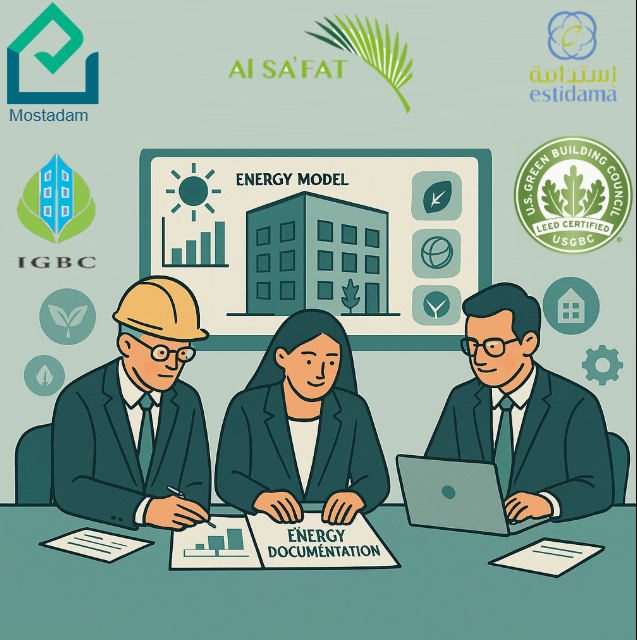

Early-stage performance modeling
We provide early-stage Shoe Box Analysis to support sustainable design decisions before architectural detailing begins. This simplified energy modelling technique uses basic geometric forms to evaluate the fundamental impact of building orientation, shape, and envelope characteristics on overall energy demand. We provide actionable insights into passive design strategies—such as optimal massing, glazing ratios, natural ventilation, shading, and thermal mass—that reduce energy loads from the outset. We provide quick yet reliable simulations that help clients and design teams explore multiple design options with speed and confidence. By embedding performance thinking at the pre-concept stage, we help reduce operational energy use, lower carbon emissions, and lay the groundwork for compliance with future sustainability targets and green certifications.
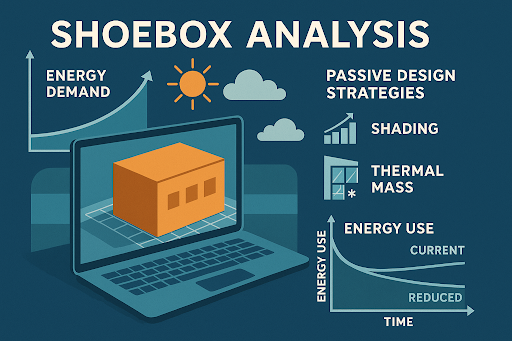
Designing for future climates
We provide Climate Resilience Reporting to help projects anticipate and adapt to future climate conditions by analyzing how buildings will perform under long-term environmental changes. Using scientifically developed future weather files based on Representative Concentration Pathways (RCPs), we simulate energy use and thermal comfort outcomes across various future climate scenarios.
We provide performance-based insights into how rising temperatures, increased humidity, and changing weather patterns may impact cooling loads, overheating risk, and year-round energy demands. We provide comprehensive reporting of key metrics such as Energy Use Intensity (EUI) and Carbon Footprint Index (CFI) for both current and future climates, enabling comparison and proactive design refinement. This service empowers developers, architects, and building operators to integrate passive resilience strategies early in the design process—ensuring comfort, operational efficiency, and compliance with long-term sustainability goals under future climate realities.
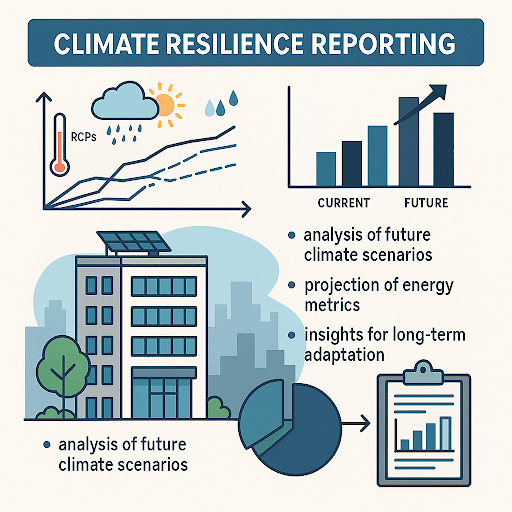
Pathway to zero energy buildings
We provide comprehensive Net Zero Studies to support the design and delivery of buildings that meet or exceed net zero energy and carbon targets. This service includes a detailed evaluation of energy demand, on-site renewable generation potential, and carbon emissions throughout the operational phase of the building. We provide energy balance modelling that accounts for both regulated and unregulated loads, while identifying opportunities for load reduction through passive design, energy-efficient systems, and behavioural strategies.
We provide clear analysis of key performance indicators such as Energy Use Intensity (EUI) and Carbon Footprint Index (CFI) to benchmark the building’s trajectory toward net zero. We also assess alignment with recognized frameworks such as Climate Challenge, or local/national net zero policies (as applicable). Our Net Zero Studies help clients make informed decisions about energy systems, electrification strategies, and renewable energy sizing—supporting cost-effective, future-proof, and environmentally responsible design outcomes.
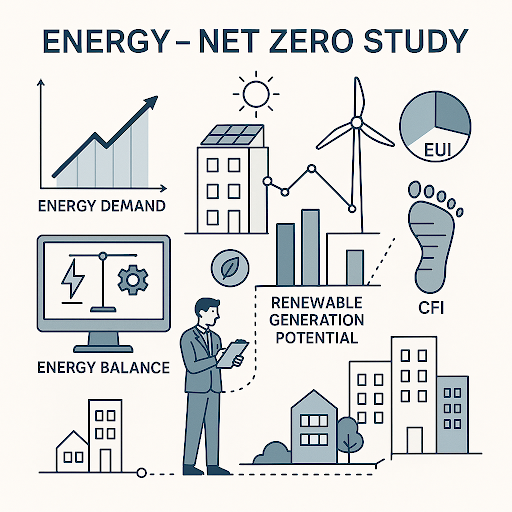
Accurate system sizing & efficiency
We provide precise and comprehensive Detailed Heat Load Analysis to support optimal HVAC system design and energy efficiency in buildings. Our analysis breaks down the total heat load into key categories, including internal gains (from occupants, lighting, and equipment), solar gains through glazing, fabric conduction losses and gains, ventilation and infiltration loads, and thermal bridging effects. This category-wise breakdown enables clear identification of dominant heat sources and losses, allowing targeted strategies to reduce peak loads and improve comfort.
We provide thorough reports with clear visualizations and data to inform HVAC sizing, control strategies, and energy-saving opportunities. By understanding each component’s contribution to heating and cooling demands, design teams can optimize envelope design, shading, ventilation strategies, and system selection to enhance performance and reduce operational costs. Our detailed heat load analysis ensures buildings are designed with precision, resilience, and sustainability at their core.
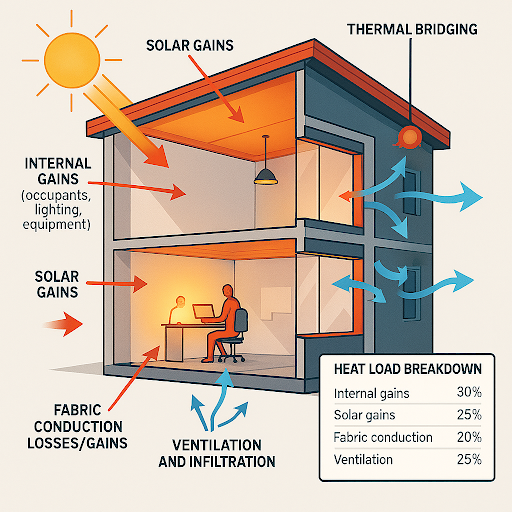
Meeting global & regional standards
We provide expert support for Energy Code Compliance, ensuring your building design meets mandatory energy efficiency and sustainability standards relevant to your project location and goals. For clients in the Middle East, we align your project with key regional codes such as the Dubai Building Code, Abu Dhabi Estidama Pearl Rating System, and the Saudi Building Code (SBC). For projects in India, we ensure compliance with the Energy Conservation Building Code (ECBC). Additionally, we support adherence to international standards including ASHRAE guidelines and the International Green Construction Code (IGCC), which are often referenced for high-performance and green building certification projects.
We provide comprehensive energy modelling, documentation, and reporting to demonstrate full compliance with these codes and standards. Our expertise streamlines the approval process, reduces compliance risk, and helps optimize building performance—enabling clients to meet regulatory requirements while advancing sustainability and operational efficiency.
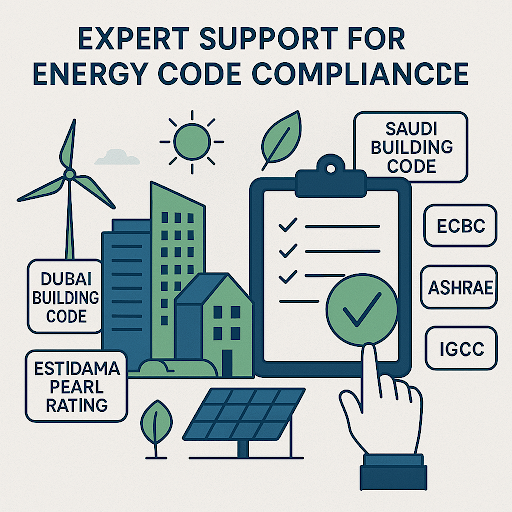
Energy credits & documentation support
We provide expert assistance in preparing detailed energy documentation tailored to various green building certification programs, including MOSTADAM, Al Safat, Estidama Pearl Rating System, GRIHA, IGBC, and LEED. Our approach begins with a thorough review of the project’s design and energy model to identify all relevant credits and compliance pathways. We systematically collect and verify data, run simulations aligned with certification protocols, and compile clear, well-structured reports that meet specific documentation requirements. Throughout the entire process—from concept and schematic design through to final design and construction stages—we actively engage and collaborate with all stakeholders, including architects, engineers, and certifying authorities. This ongoing interaction ensures accuracy, responsiveness, and alignment with project goals. By combining technical expertise with strong stakeholder coordination, we streamline documentation and boost the likelihood of successful certification while offering valuable insights to enhance building energy performance.
